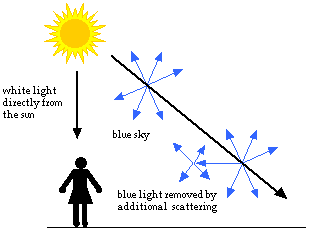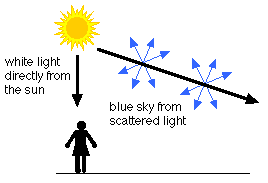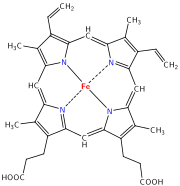| Nominal | Actual |
|---|---|
| 1" x 2" | 3/4" x 1-1/2" |
| 1" x 3" | 3/4" x 2-1/2" |
| 1" x 4" | 3/4" x 3-1/2" |
| 1" x 5" | 3/4" x 4-1/2" |
| 1" x 6" | 3/4" x 5-1/2" |
| 1" x 7" | 3/4" x 6-1/4" |
| 1" x 8" | 3/4" x 7-1/4" |
| 1" x 10" | 3/4" x 9-1/4" |
| 1" x 12" | 3/4" x 11-1/4" |
| 1-1/4" x 4" | 1" x 3-1/2" |
| 1-1/4" x 6" | 1" x 5-1/2" |
| 1-1/4" x 8" | 1" x 7-1/4" |
| 1-1/4" x 10" | 1" x 9-1/4" |
| 1-1/4" x 12" | 1" x 11-1/4" |
| 1-1/2" x 4" | 1-1/4" x 3-1/2" |
| 1-1/2" x 6" | 1-1/4" x 5-1/2" |
| 1-1/2" x 8" | 1-1/4" x 7-1/4" |
| 1-1/2" x 10" | 1-1/4" x 9-1/4" |
| 1-1/2" x 12" | 1-1/4" x 11-1/4" |
| 2" x 4" | 1-1/2" x 3-1/2" |
| 2" x 6" | 1-1/2" x 5-1/2" |
| 2" x 8" | 1-1/2" x 7-1/4" |
| 2" x 10" | 1-1/2" x 9-1/4" |
| 2" x 12" | 1-1/2" x 11-1/4" |
| 3" x 6" | 2-1/2" x 5-1/2" |
| 4" x 4" | 3-1/2" x 3-1/2" |
| 4" x 6" | 3-1/2" x 5-1/2" |
Thursday, March 19, 2009
Lumber Dimensions
Labels:
Woodworking
Why the sky is blue.
The atmosphere does not act as a giant mirror reflecting the oceans. Unfortunately it is a bit more complicated.


As you look closer to the horizon, the sky appears much paler in color. To reach you, the scattered blue light must pass through more air. Some of it gets scattered away again in other directions. Less blue light reaches your eyes. The color of the sky near the horizon appears paler or white.
So there you go, that invisible stuff that helps you breath also refracts sunlight. It isn't so crazy if you stop and remember real world experiences like air shaking above pavement on a hot day. Of course a lot of the pretty colors also come from pollutants in the air, as light has to pass through more of these on the horizon as well.
Cheers!
Source
Science Made Simple
The blue color of the sky is due to Rayleigh scattering. As light moves through the atmosphere, most of the longer wavelengths pass straight through. Little of the red, orange and yellow light is affected by the air.
However, much of the shorter wavelength light is absorbed by the gas molecules. The absorbed blue light is then radiated in different directions. It gets scattered all around the sky. Whichever direction you look, some of this scattered blue light reaches you. Since you see the blue light from everywhere overhead, the sky looks blue (left picture).

As you look closer to the horizon, the sky appears much paler in color. To reach you, the scattered blue light must pass through more air. Some of it gets scattered away again in other directions. Less blue light reaches your eyes. The color of the sky near the horizon appears paler or white.
So there you go, that invisible stuff that helps you breath also refracts sunlight. It isn't so crazy if you stop and remember real world experiences like air shaking above pavement on a hot day. Of course a lot of the pretty colors also come from pollutants in the air, as light has to pass through more of these on the horizon as well.
Cheers!
Source
Science Made Simple
Labels:
Makes you think
Blood is red

 The primary cell in our veins is RBC (Red Blood Cells). Red Blood Cells are comprised primarily of a protein chemical called hemoglobin which contains the element iron (Fe). Iron is great at attaching to Oxygen, and when it does so it turns red.
The primary cell in our veins is RBC (Red Blood Cells). Red Blood Cells are comprised primarily of a protein chemical called hemoglobin which contains the element iron (Fe). Iron is great at attaching to Oxygen, and when it does so it turns red.When you get a nose bleed or have blood drawn it is a darker richer red because it is carrying more oxygen.
So what are the RBCs flowing around in? Plasma. Made of 90% water, making it mostly clear. You can have this drawn at a blood bank as well, and agree that it is mostly clear. A little opaque and gross looking, but not red (or blue for that matter).
So the argument for blood being blue comes primarily from observing ones veins. This means looking through your skin and the vein walls to determine the color. Therefor one must assume that both skin and the vein walls do not act like a colored transparency and change our perception...
Besides, I remember when the magic school bus took a field trip inside of one of the students who had a cold. I believe the river was red.
Sources:
The Franklin Institute.
Labels:
Makes you think
Thursday, March 12, 2009
Sun in Terminal
Java is part of the ubuntu restricted extras
When Sun installs java on your ubuntu computer (terminal) and you need to hit
Hit tab and you'll see the Ok highlight, then hit enter.
Same trick for the next screen
When Sun installs java on your ubuntu computer (terminal) and you need to hit
Hit tab and you'll see the Ok highlight, then hit enter.
Same trick for the next screen
Labels:
Linux
Wednesday, March 11, 2009
Enter in Excel
Ever try to hit enter to have a line break in the same cell, only to find that you are now in the cell below the one you were writing in?
If you hit alt+enter it acts as a line break! Nifty.
If you hit alt+enter it acts as a line break! Nifty.
Labels:
Microsoft Office
Subscribe to:
Posts (Atom)
